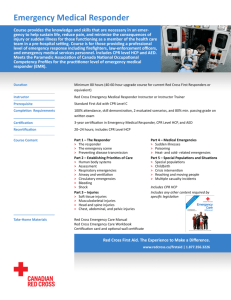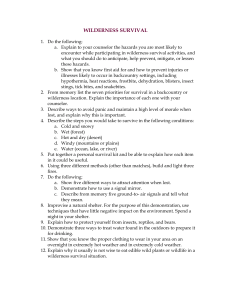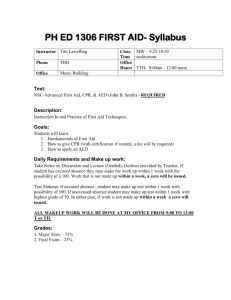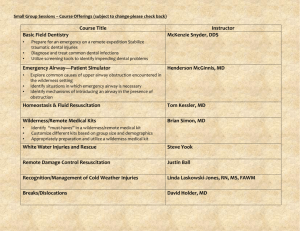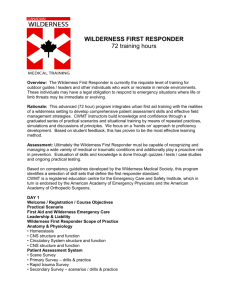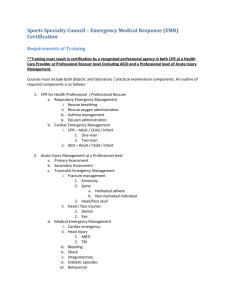Course Outline - Sirius Wilderness Medicine
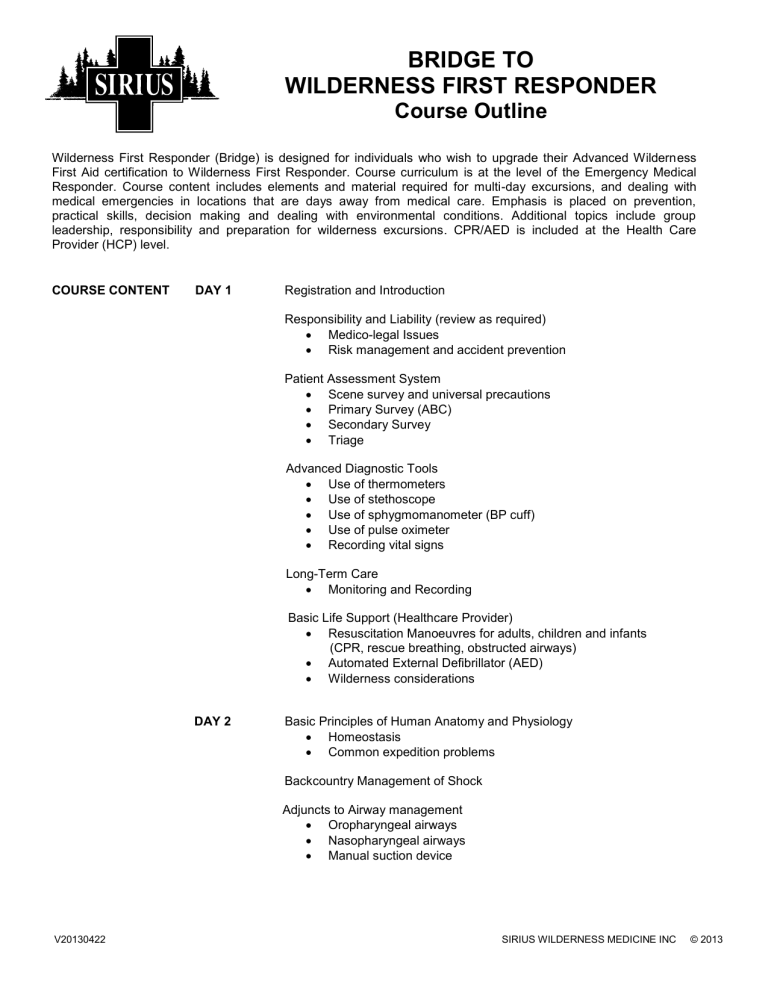
BRIDGE TO
WILDERNESS FIRST RESPONDER
Course Outline
Wilderness First Responder (Bridge) is designed for individuals who wish to upgrade their Advanced Wilderness
First Aid certification to Wilderness First Responder. Course curriculum is at the level of the Emergency Medical
Responder. Course content includes elements and material required for multi-day excursions, and dealing with medical emergencies in locations that are days away from medical care. Emphasis is placed on prevention, practical skills, decision making and dealing with environmental conditions. Additional topics include group leadership, responsibility and preparation for wilderness excursions. CPR/AED is included at the Health Care
Provider (HCP) level.
COURSE CONTENT DAY 1 Registration and Introduction
Responsibility and Liability (review as required)
Medico-legal Issues
Risk management and accident prevention
Patient Assessment System
Scene survey and universal precautions
Primary Survey (ABC)
Secondary Survey
Triage
Advanced Diagnostic Tools
Use of thermometers
Use of stethoscope
Use of sphygmomanometer (BP cuff)
Use of pulse oximeter
Recording vital signs
Long-Term Care
Monitoring and Recording
Basic Life Support (Healthcare Provider)
Resuscitation Manoeuvres for adults, children and infants
(CPR, rescue breathing, obstructed airways)
Automated External Defibrillator (AED)
Wilderness considerations
DAY 2 Basic Principles of Human Anatomy and Physiology
Homeostasis
Common expedition problems
Backcountry Management of Shock
Adjuncts to Airway management
Oropharyngeal airways
Nasopharyngeal airways
Manual suction device
V20130422 SIRIUS WILDERNESS MEDICINE INC © 2013
Oxygen Delivery Equipment and Application
Oxygen and equipment set up
Bag valve mask
Oxygen masks and delivery
CPR face mask with O
2
port
Backcountry Water Disinfection
Soft Tissues Injuries
Types of wounds
Bleeding management and priorities
Preventing infection and wound cleaning
Wound closures
Technical dressing and long-term care
Emergency Communication, Decision Making and Evacuation
DAY 3 First Aid Kits and Specialized Equipment for First Responders
Trauma kit contents
Use of trauma kit
Use of personal protective devices
Face mask
Use of gloves
Environmental Problems (Review and Simulations)
Hypothermia and frostbite
Hyperthermia
Dehydration and rehydration
Lightning
Snow Blindness
Wildlife bites and stings
Submersion accidents
Altitude sickness
Diving emergencies
Traumatic Injuries (Review and Simulations)
Head injuries
Spinal cord injuries
Head immobilization devices o Cervical collars o Improvised collars o Backboard immobilisation o Improvised litters
Chest injuries
Abdominal Injuries
DAY 4 Musculoskeletal Injuries
Types of injuries
General treatment (RICE)
Immobilisation techniques
Stabilisation techniques
Commercial splinting devices
V20130422 SIRIUS WILDERNESS MEDICINE INC © 2013
DAY 5
Transport and Carries
Rolls
Improvised litters
Emergency Leadership
Incident Command System (ICS)
Working with Emergency Medical Services (EMS)
Search and Rescue (SAR)
Medical Problems
Preparation and assessment
Cardiovascular diseases
Seizures and neurological disorders
Diabetes
Non-traumatic abdominal emergencies
Asthma
Allergic Reactions
Poison and Toxins
Genitourinary emergencies
Medication
Considerations for use
Common medication found in the backcountry
Psychological and Emotional Stress
Course Review
Practical Exam
Exam and Exam Review
Course Debriefing
V20130422 SIRIUS WILDERNESS MEDICINE INC © 2013
